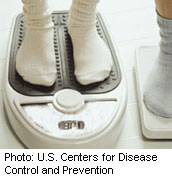- Skip Storing This Everyday Product in the Fridge Door
- Green Tea + B3 Pairing May Boost Brain Health
- Navigating Your Midlife Crisis: Embracing New Possibilities
- City Raccoons Showing Signs of Domestication
- Mapping the Exposome: Science Broadens Focus to Environmental Disease Triggers
- One Week Less on Social Media Linked to Better Mental Health
- Your Brain Changes in Stages as You Age, Study Finds
- Some Suicide Victims Show No Typical Warning Signs, Study Finds
- ByHeart Formula Faces Lawsuits After Babies Sickened With Botulism
- Switch to Vegan Diet Could Cut Your Greenhouse Gas Emissions in Half
Childhood Obesity Quadruples Chances of Adult Hypertension: Study


THURSDAY, Sept. 12Obese children have a four times greater risk of having high blood pressure when they reach adulthood compared to normal weight kids, new research shows.
The study authors also found that overweight children had double the risk of high blood pressure, or hypertension, later in life.
“We’ve shown that the risk for hypertension starts in childhood,” said study author Dr. Sara Watson, a pediatric endocrinology fellow at Riley Hospital for Children at Indiana University in Indianapolis. “That period is very important. There are changes in obese children that contribute to risk of cardiometabolic diseases.” So-called cardiometabolic diseases are caused by high blood pressure, high blood sugar and cholesterol levels, and excess belly fat.
If left unchecked, high blood pressure can lead to cardiovascular disease, heart attack and stroke.
Starting in 1986, the researchers tracked the development of over 1,100 healthy adolescents from Indianapolis. Doctors checked their height, weight and blood pressure twice a year, finding that about two-thirds were normal weight, while 16 percent were obese and 16 percent were overweight.
The researchers followed up this year with the now-adult study participants. About 26 percent of obese children had ended up with high blood pressure as adults, compared with 14 percent of overweight children and just 6 percent of normal weight children. The team was scheduled to report on its data Thursday at an American Heart Association meeting in New Orleans.
Watson said the increased risk for kids who are simply overweight is in some ways more troubling than the risk associated for obese children.
“The risk is double for the kids that are overweight,” Watson said. “Right now, a lot of our focus is on obese children, but I think it’s important when kids are in the overweight category to address them as well, because their risk is high, too.”
The 27-year study is important “because there are relatively few studies that have been done looking at the long-term impact of childhood obesity on adult health,” said Myles Faith, an associate professor of nutrition at the Gillings School of Global Public Health at the University of North Carolina, in Chapel Hill. “It takes a long time to see the development of disease, and following children over time is a mighty work. These long-term studies are a precious resource for science.”
Families and pediatricians need to keep an eye on kids’ body mass index (BMI) and take steps to help children control their weight, Faith and Watson said. BMI is a measurement based on height and weight. Parents should insist that pediatricians track their child’s BMI, and be ready to participate in healthy eating and exercise.
“We have good evidence that family treatments for childhood obesity can improve BMI and can improve blood pressure in adolescents,” Faith said. “Strategies involving the family can be helpful in reducing childhood obesity. It’s important to think of this for the family unit as well.”
Other studies presented at the heart association meeting also touched upon children and high blood pressure.
Children who have one or more high blood pressure readings are three times more likely to develop hypertension as adults, one report discovered.
Using the same pool of Indianapolis kids, researchers found that the rate of high blood pressure during adulthood was 8.6 percent for children who didn’t have a high reading when they were young. That rate jumped to 18 percent for adults who had at least one high reading as a kid, and 35 percent for adults who had two or more high readings as children.
“This study highlights the need for pediatricians to regularly check blood pressure and weight,” study author Wanzhu Tu, a professor of biostatistics at Indiana University School of Medicine in Indianapolis, said in a news release from the American Heart Association. “An occasional increase in blood pressure does not justify treatment, but it does justify following these children more carefully.”
Other research found that measuring the sodium levels of a child’s urine can help doctors identify those at risk for adult hypertension.
Doctors used a urine screen to test the amount of sodium retention in a group of 19 children. Sodium retention increases fluid in the blood vessels, which can raise blood pressure.
Eight children were found to be retaining sodium, and of those kids, seven also had high blood pressure.
“Hypertension is no longer an adult disease,” senior researcher Gregory Harshfield, director of the Institute of the Georgia Prevention Center at the Medical College of Georgia at Georgia Regents University in Augusta, explained in the news release.
The data and conclusions of research presented at medical meetings should be viewed as preliminary until published in a peer-reviewed journal.
More information
For more on childhood obesity, go to the U.S. Centers for Disease Control and Prevention.
Source: HealthDay
Copyright © 2025 HealthDay. All rights reserved.










